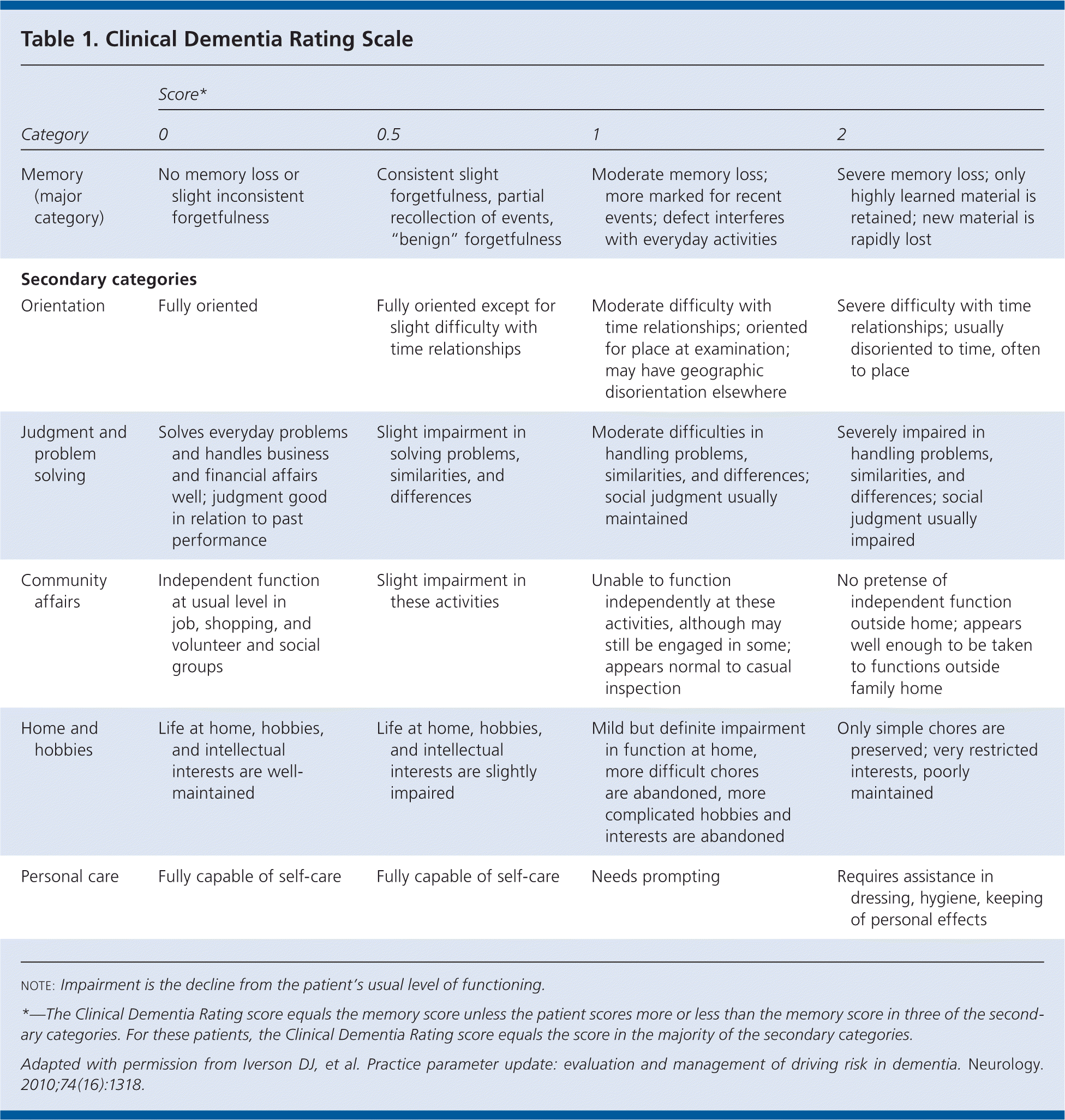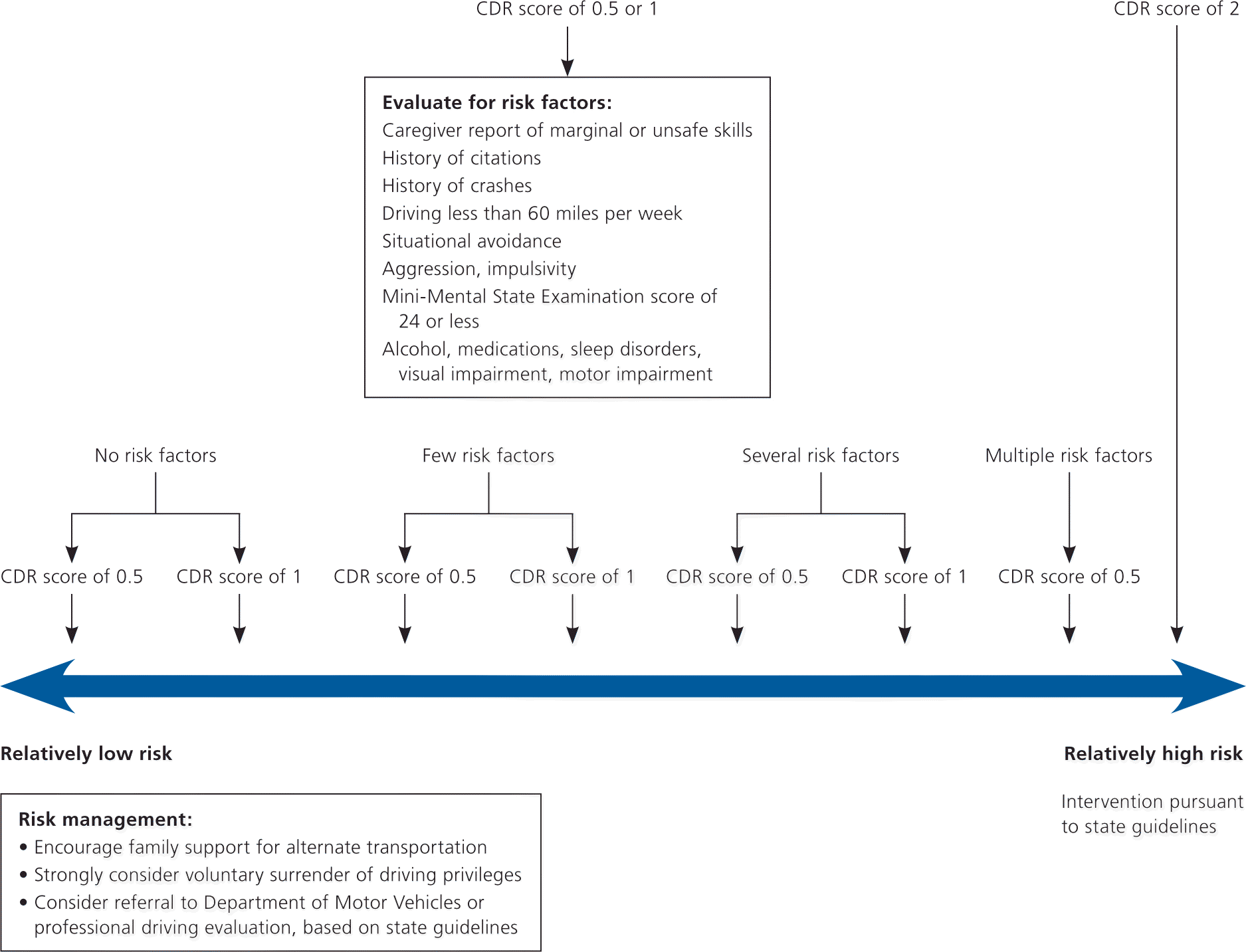
Am Fam Physician. 2010;82(9):1144-1147
Guideline source: American Academy of Neurology
Literature search described? Yes
Evidence rating system used? Yes
Published source: Neurology, April 20, 2010
Available at: http://www.neurology.org/cgi/content/full/74/16/1316
Studies have found that up to 76 percent of persons with dementia are able to pass an on-road driving test and are considered safe drivers. However, these drivers are considered high risk, and physicians are challenged with the task of determining which patients are cognitively impaired and at risk of unsafe driving, without restricting those who can still drive safely.
Reports of driving history and the Mini-Mental State Examination, alone or in combination with other cognitive tests, have been used to determine if a person is a safe driver. These tests provide information about the safety of a driver but have relatively low sensitivity and specificity. Based on the need for a more specific test, the Quality Standards Subcommittee of the American Academy of Neurology (AAN) updated guidelines for the evaluation and management of driving risk in persons with dementia. The new evidence-based guidelines offer characteristics that can help to identify persons that are at risk of unsafe driving.
The following evidence ratings were used by the AAN to determine the strength of recommendations: Level A = established as effective, ineffective, or harmful for the given condition in the specified population (i.e., should be done, or should not be done); Level B = probably effective, ineffective, or harmful for the given condition in the specified population (i.e., should be considered, or should not be considered); Level C = possibly effective, ineffective, or harmful for the given condition in the specified population (i.e., may be considered, or may not be considered); or Level U = data inadequate or conflicting, or treatment is unproved (no recommendation).
Recommendations
ASSESSMENT OF DEMENTIA
Evidence has shown that persons with a Clinical Dementia Rating score (Table 1) of 1 or more pose a higher risk of unsafe driving and should be discouraged from doing so. However, revoking driving privileges prematurely can have a negative impact on a person's life. To avoid stopping a person's driving privileges too soon, physicians should consider additional factors that can help determine if a person is a safe driver.

| Category | Score* | |||
|---|---|---|---|---|
| 0 | 0.5 | 1 | 2 | |
| Memory (major category) | No memory loss or slight inconsistent forgetfulness | Consistent slight forgetfulness, partial recollection of events, “benign” forgetfulness | Moderate memory loss; more marked for recent events; defect interferes with everyday activities | Severe memory loss; only highly learned material is retained; new material is rapidly lost |
| Secondary categories | ||||
| Orientation | Fully oriented | Fully oriented except for slight difficulty with time relationships | Moderate difficulty with time relationships; oriented for place at examination; may have geographic disorientation elsewhere | Severe difficulty with time relationships; usually disoriented to time, often to place |
| Judgment and problem solving | Solves everyday problems and handles business and financial affairs well; judgment good in relation to past performance | Slight impairment in solving problems, similarities, and differences | Moderate difficulties in handling problems, similarities, and differences; social judgment usually maintained | Severely impaired in handling problems, similarities, and differences; social judgment usually impaired |
| Community affairs | Independent function at usual level in job, shopping, and volunteer and social groups | Slight impairment in these activities | Unable to function independently at these activities, although may still be engaged in some; appears normal to casual inspection | No pretense of independent function outside home; appears well enough to be taken to functions outside family home |
| Home and hobbies | Life at home, hobbies, and intellectual interests are well-maintained | Life at home, hobbies, and intellectual interests are slightly impaired | Mild but definite impairment in function at home, more difficult chores are abandoned, more complicated hobbies and interests are abandoned | Only simple chores are preserved; very restricted interests, poorly maintained |
| Personal care | Fully capable of self-care | Fully capable of self-care | Needs prompting | Requires assistance in dressing, hygiene, keeping of personal effects |
The following characteristics are useful for identifying persons at increased risk of unsafe driving:
Clinical Dementia Rating scale (Level A)
Caregiver's rating of a person's driving ability as marginal or unsafe (Level B)
History of traffic citations (Level C)
History of crashes (Level C)
Reduced driving mileage (Level C)
Self-reported situational avoidance (Level C)
Mini-Mental State Examination scores of 24 or less (Level C)
Aggressive or impulsive personality characteristics (Level C)
Characteristics that should not be used in determining if a person is an unsafe driver include the person's self-rating of his or her driving ability (Level A), and the lack of situational avoidance (Level C). There is not enough evidence to determine if neuropsychological testing and interventional strategies are beneficial in persons with dementia (Level U).
EVALUATING RISK
A physician's judgment of a person's ability to drive should be the first consideration in determining driving risk. Additional information, such as history of crashes and the Clinical Dementia Rating score, can then be considered using an algorithm that assesses driving competence and risk management in persons with dementia (Figure 1).
If a person is determined to be a high-risk driver, he or she may voluntarily forfeit driving privileges. Persons who are not ready to stop driving should be referred for a professional driving assessment based on state reporting laws, and should be reassessed every six months. It is also important that these persons are made aware that as the severity of dementia increases, driving privileges will need to cease.

